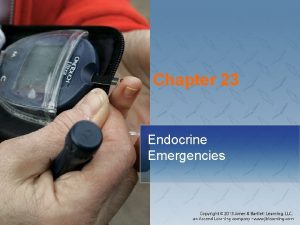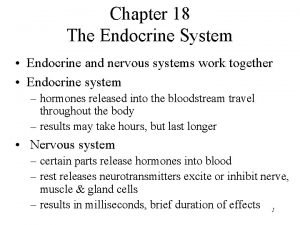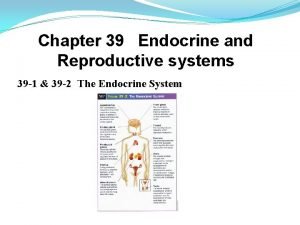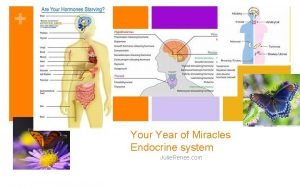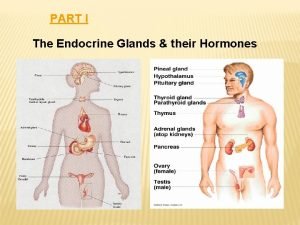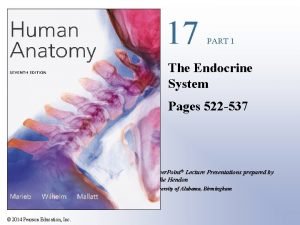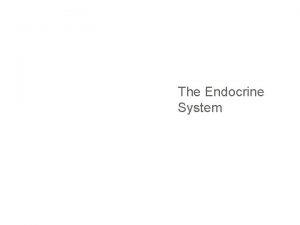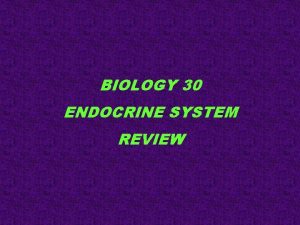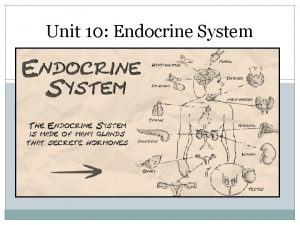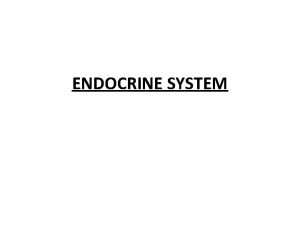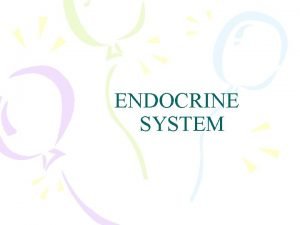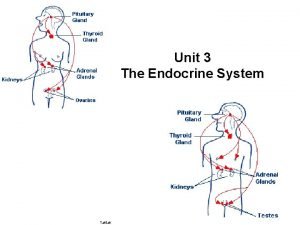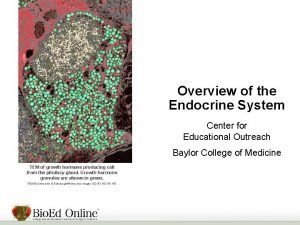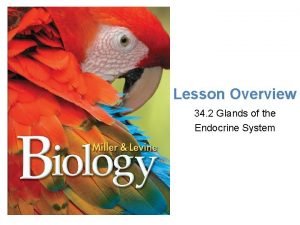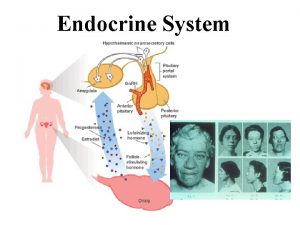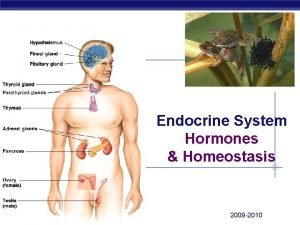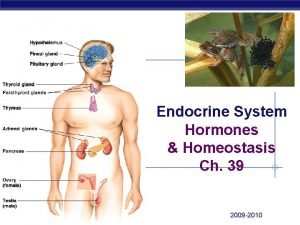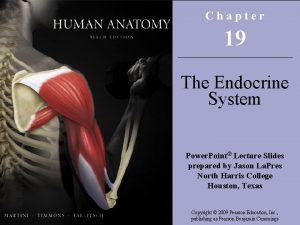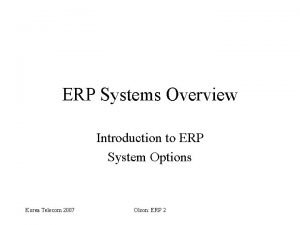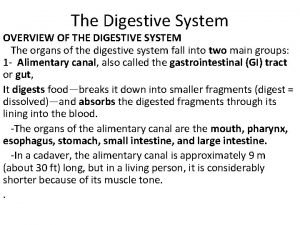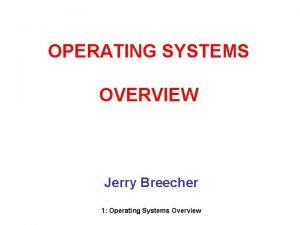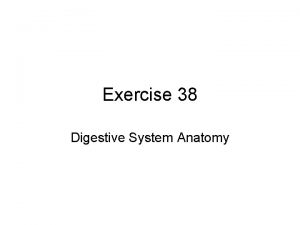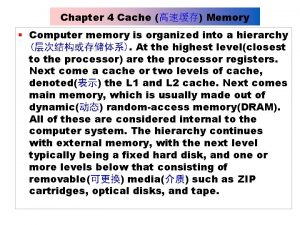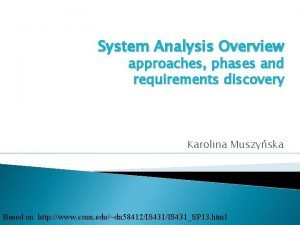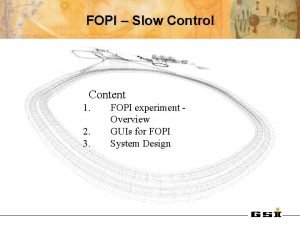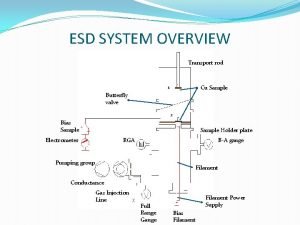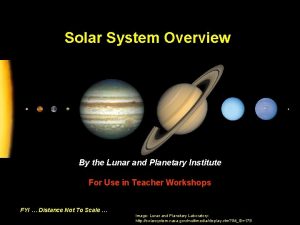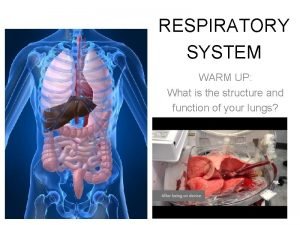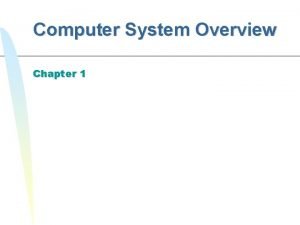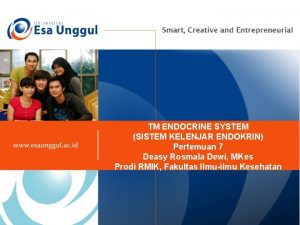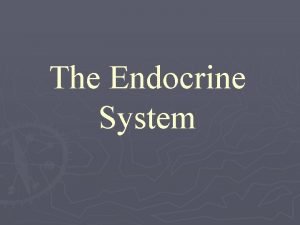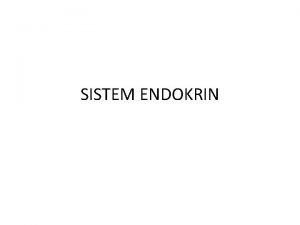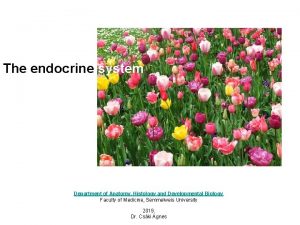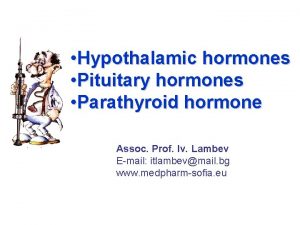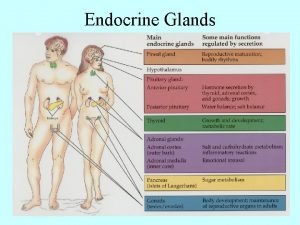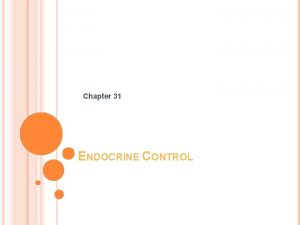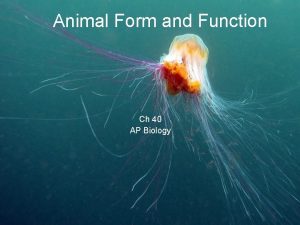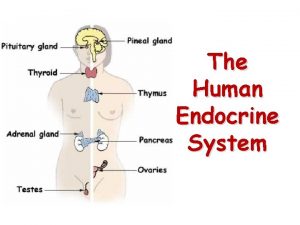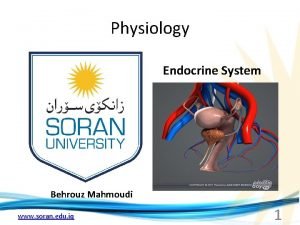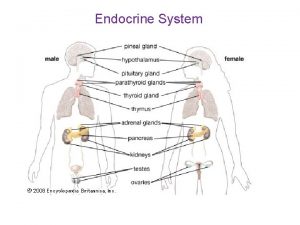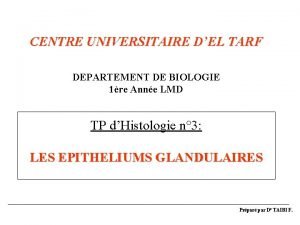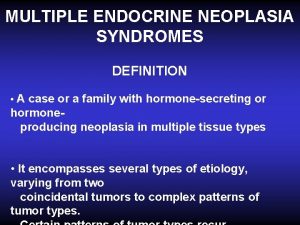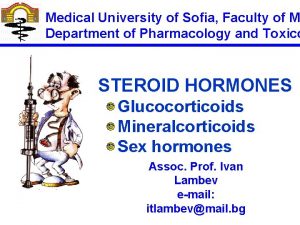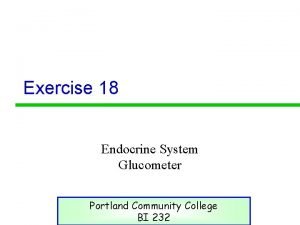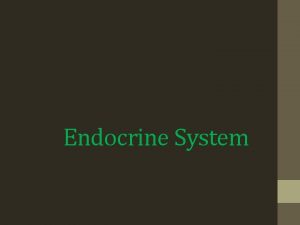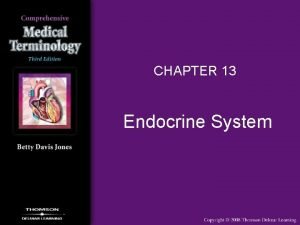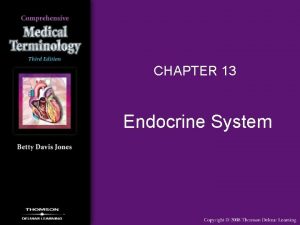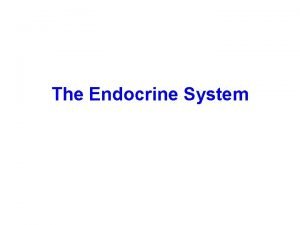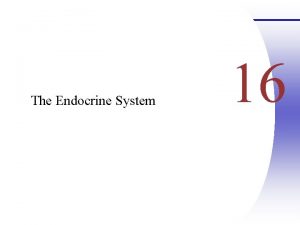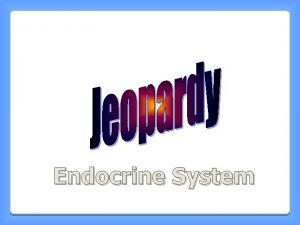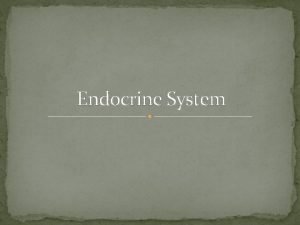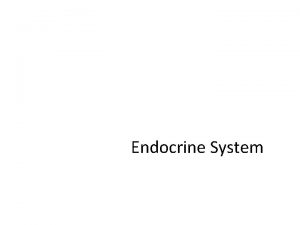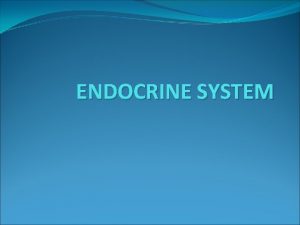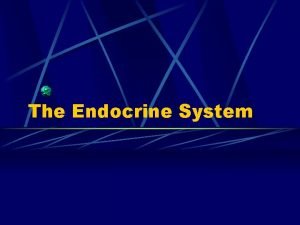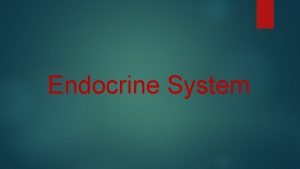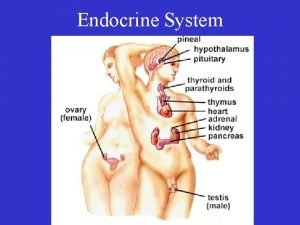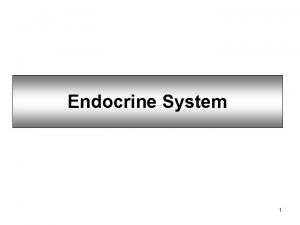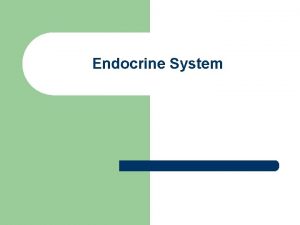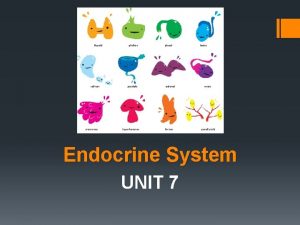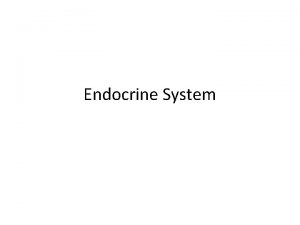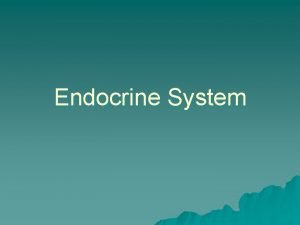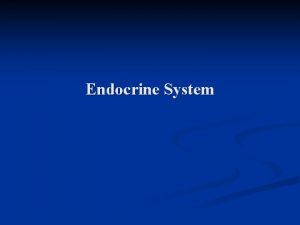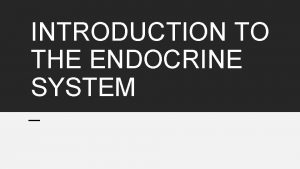Chapter 16 Endocrine System Endocrine System Overview Acts































































































- Slides: 95

Chapter 16 Endocrine System

Endocrine System: Overview • Acts with the nervous system to coordinate and integrate the activity of body cells • Influences metabolic activities by means of hormones transported in the blood • Responses occur more slowly but tend to last longer than those of the nervous system • Endocrine glands: pituitary, thyroid, parathyroid, adrenal, and pineal glands

Endocrine System: Overview • Some organs produce both hormones and exocrine products (e. g. , pancreas and gonads) • The hypothalamus has both neural and endocrine functions • Other tissues and organs that produce hormones include adipose cells, thymus, cells in the walls of the small intestine, stomach, kidneys, and heart

Pineal gland Hypothalamus Pituitary gland Thyroid gland Parathyroid glands (on dorsal aspect of thyroid gland) Thymus Adrenal glands Pancreas Ovary (female) Testis (male) Figure 16. 1

Chemical Messengers • Hormones: long-distance chemical signals that travel in the blood or lymph • Two main classes 1. Amino acid-based hormones 2. Steroids • Amines, thyroxine, peptides, and proteins • Synthesized from cholesterol • Gonadal and adrenocortical hormones

Mechanisms of Hormone Action • Hormone action on target cells 1. Alter plasma membrane permeability of membrane potential by opening or closing ion channels 2. Stimulate synthesis of proteins or regulatory molecules 3. Activate or deactivate enzyme systems 4. Induce secretory activity 5. Stimulate mitosis

Mechanisms of Hormone Action • Two mechanisms, depending on their chemical nature 1. Water-soluble hormones (all amino acid–based hormones except thyroid hormone) • Cannot enter the target cells • Act on plasma membrane receptors • Coupled by G proteins to intracellular second messengers that mediate the target cell’s response 2. Lipid-soluble hormones (steroid and thyroid hormones) • Act on intracellular receptors that directly activate genes

Intracellular Receptors and Direct Gene Activation • Steroid hormones and thyroid hormone 1. Diffuse into their target cells and bind with intracellular receptors 2. Receptor-hormone complex enters the nucleus 3. Receptor-hormone complex binds to a specific region of DNA 4. This prompts DNA transcription to produce m. RNA 5. The m. RNA directs protein synthesis

Steroid hormone Plasma membrane Extracellular fluid 1 The steroid hormone diffuses through the plasma membrane and binds an intracellular receptor. Cytoplasm Receptor protein Receptorhormone complex 2 The receptor- Nucleus Hormone response elements DNA m. RNA hormone complex enters the nucleus. 3 The receptor- hormone complex binds a hormone response element (a specific DNA sequence). 4 Binding initiates transcription of the gene to m. RNA. 5 The m. RNA directs New protein synthesis. Figure 16. 3

Target Cell Specificity • Target cells must have specific receptors to which the hormone binds –ACTH receptors are only found on certain cells of the adrenal cortex –Thyroxin receptors are found on nearly all cells of the body

Target Cell Activation • Target cell activation depends on three factors 1. Blood levels of the hormone 2. Relative number of receptors on or in the target cell 3. Affinity of binding between receptor and hormone

Target Cell Activation • Hormones influence the number of their receptors –Up-regulation—target cells form more receptors in response to the hormone –Down-regulation—target cells lose receptors in response to the hormone

Hormones in the Blood • Hormones circulate in the blood either free or bound –Steroids and thyroid hormone are attached to plasma proteins –All others circulate without carriers • The concentration of a circulating hormone reflects: –Rate of release –Speed of inactivation and removal from the body

Hormones in the Blood • Hormones are removed from the blood by –Degrading enzymes –Kidneys –Liver –Half-life—the time required for a hormone’s blood level to decrease by half

Interaction of Hormones at Target Cells • Multiple hormones may interact in several ways –Permissiveness: one hormone cannot exert its effects without another hormone being present –Synergism: more than one hormone produces the same effects on a target cell –Antagonism: one or more hormones opposes the action of another hormone

Control of Hormone Release • Blood levels of hormones –Are controlled by negative feedback systems –Vary only within a narrow desirable range • Hormones are synthesized and released in response to 1. Humoral stimuli 2. Neural stimuli 3. Hormonal stimuli

Humoral Stimuli • Changing blood levels of ions and nutrients directly stimulates secretion of hormones • Example: Ca 2+ in the blood –Declining blood Ca 2+ concentration stimulates the parathyroid glands to secrete PTH (parathyroid hormone) –PTH causes Ca 2+ concentrations to rise and the stimulus is removed

(a) Humoral Stimulus 1 Capillary blood contains low concentration of Ca 2+, which stimulates… Capillary (low Ca 2+ in blood) Thyroid gland Parathyroid (posterior view) glands PTH Parathyroid glands 2 …secretion of parathyroid hormone (PTH) by parathyroid glands* Figure 16. 4 a

Neural Stimuli • Nerve fibers stimulate hormone release –Sympathetic nervous system fibers stimulate the adrenal medulla to secrete catecholamines

(b) Neural Stimulus 1 Preganglionic sympathetic fibers stimulate adrenal medulla cells… CNS (spinal cord) Preganglionic sympathetic fibers Medulla of adrenal gland Capillary 2 …to secrete catechola- mines (epinephrine and norepinephrine) Figure 16. 4 b

Hormonal Stimuli • Hormones stimulate other endocrine organs to release their hormones –Hypothalamic hormones stimulate the release of most anterior pituitary hormones –Anterior pituitary hormones stimulate targets to secrete still more hormones –Hypothalamic-pituitary-target endocrine organ feedback loop: hormones from the final target organs inhibit the release of the anterior pituitary hormones

(c) Hormonal Stimulus 1 The hypothalamus secretes hormones that… Hypothalamus 2 …stimulate the anterior pituitary gland to secrete hormones that… Thyroid gland Adrenal cortex Pituitary gland Gonad (Testis) 3 …stimulate other endocrine glands to secrete hormones Figure 16. 4 c

Nervous System Modulation • The nervous system modifies the stimulation of endocrine glands and their negative feedback mechanisms –Example: under severe stress, the hypothalamus and the sympathetic nervous system are activated • As a result, body glucose levels rise

The Pituitary Gland Hypothalamus • The pituitary gland (hypophysis) has two major lobes 1. Posterior pituitary (lobe): –Pituicytes (glial-like supporting cells) and nerve fibers 2. Anterior pituitary (lobe) (adenohypophysis) –Glandular tissue

Pituitary-Hypothalamic Relationships • Posterior lobe –A downgrowth of hypothalamic neural tissue –Neural connection to the hypothalamus (hypothalamic-hypophyseal tract) –Nuclei of the hypothalamus synthesize the neurohormones oxytocin and antidiuretic hormone (ADH) –Neurohormones are transported to the posterior pituitary

1 Hypothalamic Paraventricular nucleus Supraoptic nucleus Optic chiasma Infundibulum (connecting stalk) Hypothalamichypophyseal tract Axon terminals Posterior lobe of pituitary Hypothalamus neurons synthesize oxytocin and ADH. 2 Oxytocin and ADH are Inferior hypophyseal artery transported along the hypothalamic-hypophyseal tract to the posterior pituitary. 3 Oxytocin and ADH are stored in axon terminals in the posterior pituitary. 4 Oxytocin and ADH are Oxytocin ADH released into the blood when hypothalamic neurons fire. (a) Relationship between the posterior pituitary and the hypothalamus Figure 16. 5 a

Pituitary-Hypothalamic Relationships • Anterior Lobe: –Originates as an out-pocketing of the oral mucosa –Hypophyseal portal system • Primary capillary plexus • Hypophyseal portal veins • Secondary capillary plexus • Carries releasing and inhibiting hormones to the anterior pituitary to regulate hormone secretion

Hypothalamus Hypothalamic neuron cell bodies Superior hypophyseal artery Hypophyseal portal system • Primary capillary plexus • Hypophyseal portal veins • Secondary capillary plexus Anterior lobe of pituitary TSH, FSH, LH, ACTH, GH, PRL 1 When appropriately stimulated, hypothalamic neurons secrete releasing and inhibiting hormones into the primary capillary plexus. 2 Hypothalamic hormones travel through the portal veins to the anterior pituitary where they stimulate or inhibit release of hormones from the anterior pituitary. 3 Anterior pituitary hormones are secreted into the secondary capillary plexus. (b) Relationship between the anterior pituitary and the hypothalamus Figure 16. 5 b

Anterior Pituitary Hormones • Growth hormone (GH) • Thyroid-stimulating hormone (TSH) or thyrotropin • Adrenocorticotropic hormone (ACTH) • Follicle-stimulating hormone (FSH) • Luteinizing hormone (LH) • Prolactin (PRL)

Anterior Pituitary Hormones • All are proteins • All except GH activate cyclic AMP secondmessenger systems at their targets • TSH, ACTH, FSH, and LH are all tropic hormones (regulate the secretory action of other endocrine glands)

Growth Hormone (GH) • Produced by somatotrophs • Stimulates most cells, but targets bone and skeletal muscle • Promotes protein synthesis and encourages use of fats for fuel • Most effects are mediated indirectly by insulinlike growth factors (IGFs)

Growth Hormone (GH) • GH release is regulated by –Growth hormone–releasing hormone (GHRH) –Growth hormone–inhibiting hormone (GHIH) (somatostatin)

Actions of Growth Hormone • Direct action of GH –Stimulates liver, skeletal muscle, bone, and cartilage to produce insulin-like growth factors –Mobilizes fats, elevates blood glucose by decreasing glucose uptake and encouraging glycogen breakdown (anti-insulin effect of GH)

Homeostatic Imbalances of Growth Hormone • Hypersecretion –In children results in gigantism –In adults results in acromegaly • Hyposecretion –In children results in pituitary dwarfism

Inhibits GHRH release Stimulates GHIH release Inhibits GH synthesis and release Feedback Anterior pituitary Hypothalamus secretes growth hormone—releasing hormone (GHRH), and somatostatin (GHIH) Growth hormone Direct actions (metabolic, anti-insulin) Indirect actions (growthpromoting) Liver and other tissues Produce Insulin-like growth factors (IGFs) Effects Skeletal Extraskeletal Fat Carbohydrate metabolism Increases, stimulates Increased cartilage formation and skeletal growth Increased protein synthesis, and cell growth and proliferation Increased fat breakdown and release Increased blood glucose and other anti-insulin effects Reduces, inhibits Initial stimulus Physiological response Result Figure 16. 6

Thyroid-Stimulating Hormone (Thyrotropin) • Produced by thyrotrophs of the anterior pituitary • Stimulates the normal development and secretory activity of the thyroid

Thyroid-Stimulating Hormone (Thyrotropin) • Regulation of TSH release –Stimulated by thyrotropin-releasing hormone (TRH) –Inhibited by rising blood levels of thyroid hormones that act on the pituitary and hypothalamus

Hypothalamus TRH Anterior pituitary TSH Thyroid gland Thyroid hormones Target cells Stimulates Inhibits Figure 16. 7

Adrenocorticotropic Hormone (Corticotropin) • Secreted by corticotrophs of the anterior pituitary • Stimulates the adrenal cortex to release corticosteroids

Adrenocorticotropic Hormone (Corticotropin) • Regulation of ACTH release –Triggered by hypothalamic corticotropin-releasing hormone (CRH) in a daily rhythm –Internal and external factors such as fever, hypoglycemia, and stressors can alter the release of CRH

Gonadotropins • Follicle-stimulating hormone (FSH) and luteinizing hormone (LH) • Secreted by gonadotrophs of the anterior pituitary • FSH stimulates gamete (egg or sperm) production • LH promotes production of gonadal hormones • Absent from the blood in prepubertal boys and girls

Gonadotropins • Regulation of gonadotropin release –Triggered by the gonadotropin-releasing hormone (Gn. RH) during and after puberty –Suppressed by gonadal hormones (feedback)

Prolactin (PRL) • Secreted by lactotrophs of the anterior pituitary • Stimulates milk production • Regulation of PRL release –Primarily controlled by prolactin-inhibiting hormone (PIH) (dopamine) • Blood levels rise toward the end of pregnancy • Suckling stimulates PRH release and promotes continued milk production

The Posterior Pituitary • Contains axons of hypothalamic neurons • Stores antidiuretic hormone (ADH) and oxytocin • ADH and oxytocin are released in response to nerve impulses • Both use PIP-calcium second-messenger mechanism at their targets

Oxytocin • Stimulates uterine contractions during childbirth by mobilizing Ca 2+ through a PIP 2 -Ca 2+ second-messenger system • Also triggers milk ejection (“letdown” reflex) in women producing milk • Plays a role in sexual arousal and orgasm in males and females

Antidiuretic Hormone (ADH) • Hypothalamic osmoreceptors respond to changes in blood solute concentration • If solute concentration is high –Osmoreceptors depolarize and transmit impulses to hypothalamic neurons –ADH is synthesized & released, inhibits urine formation • If solute concentration is low –ADH is not released, allowing water loss • Alcohol inhibits ADH release &causes copious urine output

Homeostatic Imbalances of ADH • ADH deficiency—diabetes insipidus; huge output of urine and intense thirst • ADH hypersecretion (after neurosurgery, trauma, or secreted by cancer cells)—syndrome of inappropriate ADH secretion (SIADH)

Thyroid Gland • Consists of two lateral lobes connected by a median mass called the isthmus • Composed of follicles that produce the glycoprotein thyroglobulin • Colloid (thyroglobulin + iodine) fills the lumen of the follicles and is the precursor of thyroid hormone • Parafollicular cells produce the hormone calcitonin

Figure 16. 8

Thyroid Hormone (TH) • Actually two related compounds –T 4 (thyroxine); has 2 tyrosine molecules + 4 bound iodine atoms –T 3 (triiodothyronine); has 2 tyrosines + 3 bound iodine atoms

Thyroid Hormone • Major metabolic hormone • Increases metabolic rate and heat production (calorigenic effect) • Plays a role in –Maintenance of blood pressure –Regulation of tissue growth –Development of skeletal and nervous systems –Reproductive capabilities

Synthesis of Thyroid Hormone • Thyroglobulin is synthesized and discharged into the follicle lumen • Iodides (I–) are actively taken into the cell, oxidized to iodine (I 2), and released into the lumen • Iodine attaches to tyrosine, mediated by peroxidase enzymes

Synthesis of Thyroid Hormone • Iodinated tyrosines link together to form T 3 and T 4 • Colloid is endocytosed and combined with a lysosome • T 3 and T 4 are cleaved and diffuse into the bloodstream

Thyroid follicle cells Colloid 1 Thyroglobulin is synthesized and discharged into the follicle lumen. Tyrosines (part of thyroglobulin molecule) Capillary 4 Iodine is attached to tyrosine in colloid, forming DIT and MIT. Golgi apparatus Rough ER Iodine 3 Iodide is oxidized to iodine. 2 Iodide (I–) is trapped (actively transported in). Iodide (I–) Lysosome T 4 T 3 DIT (T 2) MIT (T 1) Thyroglobulin colloid 5 Iodinated tyrosines are linked together to form T 3 and T 4 T 3 6 Thyroglobulin colloid is endocytosed and combined with a lysosome. 7 Lysosomal enzymes cleave T 4 and T 3 from thyroglobulin colloid and hormones diffuse into bloodstream. Colloid in lumen of follicle To peripheral tissues Figure 16. 9

Transport and Regulation of TH • T 4 and T 3 are transported by thyroxine-binding globulins (TBGs) • Both bind to target receptors, but T 3 is ten times more active than T 4 • Peripheral tissues convert T 4 to T 3

Transport and Regulation of TH • Negative feedback regulation of TH release –Rising TH levels provide negative feedback inhibition on release of TSH –Hypothalamic thyrotropin-releasing hormone (TRH) can overcome the negative feedback during pregnancy or exposure to cold

Hypothalamus TRH Anterior pituitary TSH Thyroid gland Thyroid hormones Target cells Stimulates Inhibits Figure 16. 7

Figure 16. 10

Calcitonin • Produced by parafollicular (C) cells • Antagonist to parathyroid hormone (PTH) • Inhibits osteoclast activity and release of Ca 2+ from bone • Stimulates Ca 2+ uptake and incorporation into bone • Regulated by a humoral (Ca 2+ concentration in the blood) negative feedback mechanism • No important role in humans; removal of thyroid (and its C cells) does not affect Ca 2+ homeostasis

Parathyroid Glands • Four to eight tiny glands embedded in the posterior aspect of the thyroid • Contain oxyphil cells (function unknown) and chief cells that secrete parathyroid hormone (PTH) or parathormone • PTH—most important hormone in Ca 2+ homeostasis

Pharynx (posterior aspect) Thyroid gland Parathyroid glands Chief cells (secrete parathyroid hormone) Oxyphil cells Esophagus Trachea (a) Capillary (b) Figure 16. 11

Parathyroid Hormone • Functions –Stimulates osteoclasts to digest bone matrix –Enhances reabsorption of Ca 2+ and secretion of phosphate by the kidneys –Promotes activation of vitamin D (by the kidneys); increases absorption of Ca 2+ by intestinal mucosa • Negative feedback control: rising Ca 2+ in the blood inhibits PTH release

Hypocalcemia (low blood Ca 2+) stimulates parathyroid glands to release PTH. Rising Ca 2+ in blood inhibits PTH release. Bone 1 PTH activates osteoclasts: Ca 2+ and PO 43 S released into blood. Kidney 2 PTH increases 2+ Ca reabsorption in kidney tubules. 3 PTH promotes kidney’s activation of vitamin D, which increases Ca 2+ absorption from food. Intestine Ca 2+ ions PTH Molecules Bloodstream Figure 16. 12

Homeostatic Imbalances of PTH • Hyperparathyroidism due to tumor –Bones soften and deform –Elevated Ca 2+ depresses the nervous system and contributes to formation of kidney stones • Hypoparathyroidism following gland trauma or removal –Results in tetany, respiratory paralysis, and death

Adrenal (Suprarenal) Glands • Paired, pyramid-shaped organs atop the kidneys • Structurally and functionally, they are two glands in one –Adrenal medulla—nervous tissue; part of the sympathetic nervous system –Adrenal cortex—three layers of glandular tissue that synthesize and secrete corticosteroids

Adrenal Cortex • Three layers and the corticosteroids produced –Zona glomerulosa—mineralocorticoids –Zona fasciculata—glucocorticoids –Zona reticularis—sex hormones, or gonadocorticoids

Adrenal gland • Medulla • Cortex Capsule Zona glomerulosa Zona fasciculata Zona reticularis Medulla Kidney Adrenal medulla (a) Drawing of the histology of the adrenal cortex and a portion of the adrenal medulla Figure 16. 13 a

Mineralocorticoids • Regulate electrolytes (primarily Na+ & K+) in ECF –Importance of Na+: affects ECF volume, blood pressure, levels of other ions –Importance of K+: sets RMP of cells • Aldosterone is the most potent mineralocorticoid –Stimulates Na+ reabsorption and water retention by the kidneys

Mechanisms of Aldosterone Secretion 1. Renin-angiotensin mechanism: decreased blood pressure stimulates kidneys to release renin, triggers formation of angiotensin II, a potent stimulator of aldosterone release 2. Plasma concentration of K+: Increased K+ directly influences the zona glomerulosa cells to release aldosterone 3. ACTH: causes small increases of aldosterone during stress 4. Atrial natriuretic peptide (ANP): blocks renin and aldosterone secretion, to decrease blood pressure

Primary regulators Blood volume and/or blood pressure K+ in blood Other factors Stress Blood pressure and/or blood volume Hypothalamus Kidney Heart CRH Renin Initiates cascade that produces Direct stimulating effect Anterior pituitary Atrial natriuretic peptide (ANP) ACTH Angiotensin II Inhibitory effect Zona glomerulosa of adrenal cortex Enhanced secretion of aldosterone Targets kidney tubules Absorption of Na+ and water; increased K + excretion Blood volume and/or blood pressure Figure 16. 14

Homeostatic Imbalances of Aldosterone • Aldosteronism—hypersecretion due to adrenal tumors –Hypertension and edema due to excessive Na+ –Excretion of K+ leading to abnormal function of neurons and muscle

Glucocorticoids (Cortisol) • Keep blood sugar levels relatively constant • Maintain blood pressure by increasing the action of vasoconstrictors

Glucocorticoids (Cortisol) • Cortisol is the most significant glucocorticoid –Released in response to ACTH, patterns of eating and activity, and stress –Prime metabolic effect is gluconeogenesis—formation of glucose from fats and proteins –Promotes rises in blood glucose, fatty acids, and amino acids

Homeostatic Imbalances of Glucocorticoids • Hypersecretion—Cushing’s syndrome –Depresses cartilage and bone formation –Inhibits inflammation –Depresses the immune system –Promotes changes in cardiovascular, neural, and gastrointestinal function • Hyposecretion—Addison’s disease –Also involves deficits in mineralocorticoids • Decrease in glucose and Na+ levels • Weight loss, severe dehydration, and hypotension

Figure 16. 15

Gonadocorticoids (Sex Hormones) • Most are androgens (male sex hormones) that are converted to testosterone in tissue cells or estrogens in females • May contribute to –The onset of puberty –The appearance of secondary sex characteristics –Sex drive

Adrenal Medulla • Chromaffin cells secrete epinephrine (80%) and norepinephrine (20%) • These hormones cause –Blood glucose levels to rise –Blood vessels to constrict –The heart to beat faster –Blood to be diverted to the brain, heart, and skeletal muscle

Adrenal Medulla • Epinephrine stimulates metabolic activities, bronchial dilation, and blood flow to skeletal muscles and the heart • Norepinephrine influences peripheral vasoconstriction and blood pressure

Short-term stress More prolonged stress Stress Nerve impulses Hypothalamus CRH (corticotropinreleasing hormone) Spinal cord Corticotroph cells of anterior pituitary To target in blood Preganglionic sympathetic fibers Adrenal medulla (secretes amino acidbased hormones) Catecholamines (epinephrine and norepinephrine) Short-term stress response 1. Increased heart rate 2. Increased blood pressure 3. Liver converts glycogen to glucose and releases glucose to blood 4. Dilation of bronchioles 5. Changes in blood flow patterns leading to decreased digestive system activity and reduced urine output 6. Increased metabolic rate Adrenal cortex (secretes steroid hormones) ACTH Mineralocorticoids Glucocorticoids Long-term stress response 1. Retention of sodium and water by kidneys 2. Increased blood volume and blood pressure 1. Proteins and fats converted to glucose or broken down for energy 2. Increased blood glucose 3. Suppression of immune system Figure 16. 16

Pineal Gland • Small gland hanging from the roof of the third ventricle • Pinealocytes secrete melatonin, derived from serotonin • Melatonin may affect –Timing of sexual maturation and puberty –Day/night cycles –Physiological processes that show rhythmic variations (body temperature, sleep, appetite)

Pancreas • Triangular gland behind the stomach • Has both exocrine and endocrine cells –Acinar cells (exocrine) produce an enzyme-rich juice for digestion –Pancreatic islets (islets of Langerhans) contain endocrine cells • Alpha ( ) cells produce glucagon (a hyperglycemic hormone) • Beta ( ) cells produce insulin (a hypoglycemic hormone)

Pancreatic islet (of Langerhans) • (Glucagonproducing) cells • (Insulinproducing) cells Pancreatic acinar cells (exocrine) Figure 16. 17

Glucagon • Major target is the liver, where it promotes –Glycogenolysis—breakdown of glycogen to glucose –Gluconeogenesis—synthesis of glucose from lactic acid and noncarbohydrates –Release of glucose to the blood

Insulin • Effects of insulin –Lowers blood glucose levels –Enhances membrane transport of glucose into fat and muscle cells –Participates in neuronal development and learning and memory –Inhibits glycogenolysis and gluconeogenesis

Insulin Action on Cells • Activates a tyrosine kinase enzyme receptor • Cascade leads to increased glucose uptake and enzymatic activities that –Catalyze the oxidation of glucose for ATP production –Polymerize glucose to form glycogen –Convert glucose to fat (particularly in adipose tissue)

Stimulates glucose uptake by cells Tissue cells Insulin Pancreas Stimulates glycogen formation Glucose Glycogen Blood glucose falls to normal range. Liver Stimulus Blood glucose level Blood glucose rises to normal range. Pancreas Liver Glucose Glycogen Stimulates glycogen Glucagon breakdown Figure 16. 18

Homeostatic Imbalances of Insulin • Diabetes mellitus (DM) –Due to hyposecretion or hypoactivity of insulin –Three cardinal signs of DM • Polyuria—huge urine output • Polydipsia—excessive thirst • Polyphagia—excessive hunger and food consumption • Hyperinsulinism: –Excessive insulin secretion; results in hypoglycemia, disorientation, unconsciousness

Table 16. 4

Ovaries and Placenta • Gonads produce steroid sex hormones • Ovaries produce estrogens and progesterone responsible for: –Maturation of female reproductive organs –Appearance of female secondary sexual characteristics –Breast development and cyclic changes in the uterine mucosa • The placenta secretes estrogens, progesterone, and human chorionic gonadotropin (h. CG)

Testes • Testes produce testosterone that –Initiates maturation of male reproductive organs –Causes appearance of male secondary sexual characteristics and sex drive –Is necessary for normal sperm production –Maintains reproductive organs in their functional state

Other Hormone-Producing Structures • Heart –Atrial natriuretic peptide (ANP) reduces blood pressure, blood volume, and blood Na+ concentration • Gastrointestinal tract enteroendocrine cells –Gastrin stimulates release of HCl –Secretin stimulates liver and pancreas –Cholecystokinin stimulates pancreas, gallbladder, and hepatopancreatic sphincter

Other Hormone-Producing Structures • Kidneys –Erythropoietin signals production of red blood cells –Renin initiates the renin-angiotensin mechanism • Skin –Cholecalciferol, the precursor of vitamin D • Adipose tissue –Leptin is involved in appetite control, and stimulates increased energy expenditure

Other Hormone-Producing Structures • Skeleton (osteoblasts) –Osteocalcin prods pancreatic beta cells to divide and secrete more insulin, improving glucose handling and reducing body fat • Thymus –Thymulin, thymopoietins, and thymosins are involved in normal the development of the T lymphocytes in the immune response

Developmental Aspects • Ovaries undergo significant changes with age and become unresponsive to gonadotropins; problems associated with estrogen deficiency begin to occur • Testosterone also diminishes with age, but effect is not usually seen until very old age

Developmental Aspects • GH levels decline with age and this accounts for muscle atrophy with age • TH declines with age, contributing to lower basal metabolic rates • PTH levels remain fairly constant with age, but lack of estrogen in older women makes them more vulnerable to bone-demineralizing effects of PTH
 Chapter 16
Chapter 16 Calcitonin and pth are antagonistic hormones
Calcitonin and pth are antagonistic hormones 7:13 endocrine system
7:13 endocrine system Chapter 11 endocrine system
Chapter 11 endocrine system Chapter 23 the endocrine system
Chapter 23 the endocrine system Chapter 16 lesson 3 the female reproductive system
Chapter 16 lesson 3 the female reproductive system Chapter 45 hormones and the endocrine system
Chapter 45 hormones and the endocrine system Chapter 18: the endocrine system answer key
Chapter 18: the endocrine system answer key Endocrine system and reproductive system
Endocrine system and reproductive system Endocrine system and nervous system
Endocrine system and nervous system Lympathic
Lympathic Mechanism of hormone action
Mechanism of hormone action Endocrine system
Endocrine system Financial intermediaries
Financial intermediaries What are the modifiers of human act
What are the modifiers of human act Chapter 46 digestive and endocrine disorders
Chapter 46 digestive and endocrine disorders Section 39-4 fertilization and development
Section 39-4 fertilization and development Chapter 29 endocrine and metabolic disorders
Chapter 29 endocrine and metabolic disorders Chapter 19 endocrine and hematologic emergencies
Chapter 19 endocrine and hematologic emergencies Your year of miracles
Your year of miracles Parts of the endocrine system
Parts of the endocrine system Differences between nervous system and endocrine
Differences between nervous system and endocrine Comparison of endocrine and nervous system
Comparison of endocrine and nervous system Steroids endocrine system
Steroids endocrine system Facts about the endocrine system
Facts about the endocrine system Endocrine glands of rat
Endocrine glands of rat Metabolic action of growth hormone
Metabolic action of growth hormone Exocrine glands are ductless
Exocrine glands are ductless Mammillary body
Mammillary body Figure of endocrine system
Figure of endocrine system Biology 30 endocrine system
Biology 30 endocrine system Site:slidetodoc.com
Site:slidetodoc.com Endocrine system analogy
Endocrine system analogy Introduction of endocrine system
Introduction of endocrine system Endocrine system abbreviations
Endocrine system abbreviations T4.taktak
T4.taktak Endocrine glands
Endocrine glands Endocrine system
Endocrine system Baylor
Baylor Endocrine glands
Endocrine glands Endocrine system
Endocrine system Endocrine system regents questions
Endocrine system regents questions Endocrine system regents questions
Endocrine system regents questions Pearson endocrine system
Pearson endocrine system Emt chapter 24 trauma overview
Emt chapter 24 trauma overview Chapter 14 medical overview
Chapter 14 medical overview Chapter 9 lesson 2 photosynthesis an overview
Chapter 9 lesson 2 photosynthesis an overview Chapter 12 selling overview
Chapter 12 selling overview Chapter 1 overview of verb tenses
Chapter 1 overview of verb tenses Overview of personal finance chapter 1
Overview of personal finance chapter 1 Tooth numbering system in usa
Tooth numbering system in usa Chapter 1: introduction to personal finance answer key
Chapter 1: introduction to personal finance answer key General features of animals
General features of animals Chapter 1 an overview of financial management
Chapter 1 an overview of financial management Elements and their properties section 1 metals
Elements and their properties section 1 metals Chapter 1 overview of financial statement analysis
Chapter 1 overview of financial statement analysis Erp system introduction
Erp system introduction Content database software
Content database software Computerized accounting system
Computerized accounting system Overview of the digestive system
Overview of the digestive system Sap easy cost planning
Sap easy cost planning Operating system overview
Operating system overview Gym management system erd
Gym management system erd Crypts of liberkuhn
Crypts of liberkuhn Set associative mapping in cache memory
Set associative mapping in cache memory Computer memory system overview
Computer memory system overview British school system
British school system British school system overview
British school system overview System analysis
System analysis System design overview
System design overview System overview sample
System overview sample Lpi
Lpi Lung 3 lobes
Lung 3 lobes Computer system overview
Computer system overview Istilah medis kelenjar
Istilah medis kelenjar Major endocrine glands male and female
Major endocrine glands male and female Endokrin dan eksokrin
Endokrin dan eksokrin Mechanisms of hypothalamic control over endocrine function
Mechanisms of hypothalamic control over endocrine function Endocrine anatomy
Endocrine anatomy Difference between endocrine and exocrine glands
Difference between endocrine and exocrine glands Lamina propria papillae
Lamina propria papillae Follicular epithelium
Follicular epithelium Endocrine axis
Endocrine axis Pituitary gland
Pituitary gland Endocrine exocrine
Endocrine exocrine Follicular adenoma
Follicular adenoma Whats the difference between endocrine and exocrine glands
Whats the difference between endocrine and exocrine glands Endocrine exocrine
Endocrine exocrine Testosterone endocrine gland
Testosterone endocrine gland Endocrine
Endocrine Thymic carcinoma symptoms
Thymic carcinoma symptoms Endocrine glands
Endocrine glands Glande endocrine exocrine
Glande endocrine exocrine Multiple endocrine neoplasia type 2
Multiple endocrine neoplasia type 2 Endocrine axes
Endocrine axes Endocrine organs
Endocrine organs




